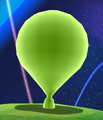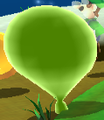Rubbery bulb
- Not to be confused with Bulb.
| Rubbery bulb | |||
|---|---|---|---|
 Model from Super Mario Galaxy | |||
| First appearance | Super Mario Galaxy (2007) | ||
| Latest appearance | Super Mario 3D All-Stars (2020) | ||
| |||
Rubbery bulbs,[1] also described as bulbs,[2][3] rubbery plants,[4] plants,[4] wiggly bulbs,[5] and green bulbs,[6] are a species in Super Mario Galaxy and Super Mario Galaxy 2. They appear as green plants with bulbous heads and thin, stretchy stems.
History
Super Mario series
Super Mario Galaxy
In Super Mario Galaxy, rubbery bulbs appear in various galaxies, most notably the Good Egg Galaxy. Their main purpose is to defeat foes that cannot be defeated via conventional methods. If Mario or Luigi hits one of them with a spin, the plant will stretch in the opposite direction, hitting any enemy or obstacle in the way. If it fails to hit an obstacle or an enemy, it will come right back and hit the player character, causing him to fall back and drop some Star Bits. If one is ground-pounded or run over by an enemy such as a Ruby Rock or a Chomp, it will become flattened and unusable for a short period of time.
Rubbery bulbs appear during the final fight with Bowser at Bowser's Galaxy Reactor, being seen in the second phase of the final battle where Mario can use them as protection against Bowser's fireballs. Using them to attack is mandatory since Bowser cannot be attacked normally by spinning and there are no lava pools to disrupt his attacks.
Super Mario Galaxy 2
Bulbs are objects in Super Mario Galaxy 2. They are encountered in Sky Station Galaxy, the Freezy Flake Galaxy, and Battle Belt Galaxy. Bulbs keep their same appearance and use from the previous game, but they are less common. They are now used to defeat certain enemies such as Prickly Piranha Plants and Homing Chomps. Spindleburrs, a spiky variant, also make an appearance.
Mario Party 10
Small bulbs are background elements in Mario Party 10. Three of them can be seen on the Rosalina Board, on a grassy field with two Lumas and a flower bed in the northwestern part.
Gallery
Naming
Internal names
| Game | File | Name | Meaning
|
|---|---|---|---|
| Super Mario Galaxy Super Mario Galaxy 2 |
ObjectData/PunchingKinoko.arc | PunchingKinoko | Punching Mushroom |
| StageData/ObjNameTable.arc/ObjNameTable.tbl SystemData/ObjNameTable.arc/ObjNameTable.tbl |
パンチングキノコ (Panchingu Kinoko) |
Names in other languages
| Language | Name | Meaning | Notes |
|---|---|---|---|
| Japanese | パンチボンボン[7] Panchi Bonbon |
Punch Bonbon | |
| German | Streckpflanze[?] | Stretching Plant | |
| Italian | Pianta Punching Ball[?] | Punching Ball Plant |
References
- ^ Black, Fletcher (November 9, 2007). Super Mario Galaxy PRIMA Official Game Guide. Prima Games (American English). ISBN 978-0-7615-5643-5. Page 27, 43, 48, 49, 53, 304.
- ^ Black. Super Mario Galaxy PRIMA Official Game Guide. Page 48 and 50.
- ^ Browne, Catherine (May 23, 2010). Super Mario Galaxy 2: PRIMA Official Game Guide. Roseville: Random House Inc. ISBN 978-0-30746-907-6. Page 41 and 231.
- ^ a b Black. Super Mario Galaxy PRIMA Official Game Guide. Page 303.
- ^ Browne. Super Mario Galaxy 2 PRIMA Official Game Guide. Page 41.
- ^ Browne. Super Mario Galaxy 2 PRIMA Official Game Guide. Page 231.
- ^ Sakai, Kazuya (Ambit), kikai, Akinori Sao, Junko Fukuda, Kunio Takayama, and Ko Nakahara (Shogakukan), editors. (October 19, 2015). 『スーパーマリオブラザーズ百科: 任天堂公式ガイドブック』. Tokyo: Shogakukan (Japanese). ISBN 978-4-09-106569-8. Page 137 and 171.


